lights YAMAHA GIGGLE50 2009 Owners Manual
[x] Cancel search | Manufacturer: YAMAHA, Model Year: 2009, Model line: GIGGLE50, Model: YAMAHA GIGGLE50 2009Pages: 74, PDF Size: 0.9 MB
Page 6 of 74
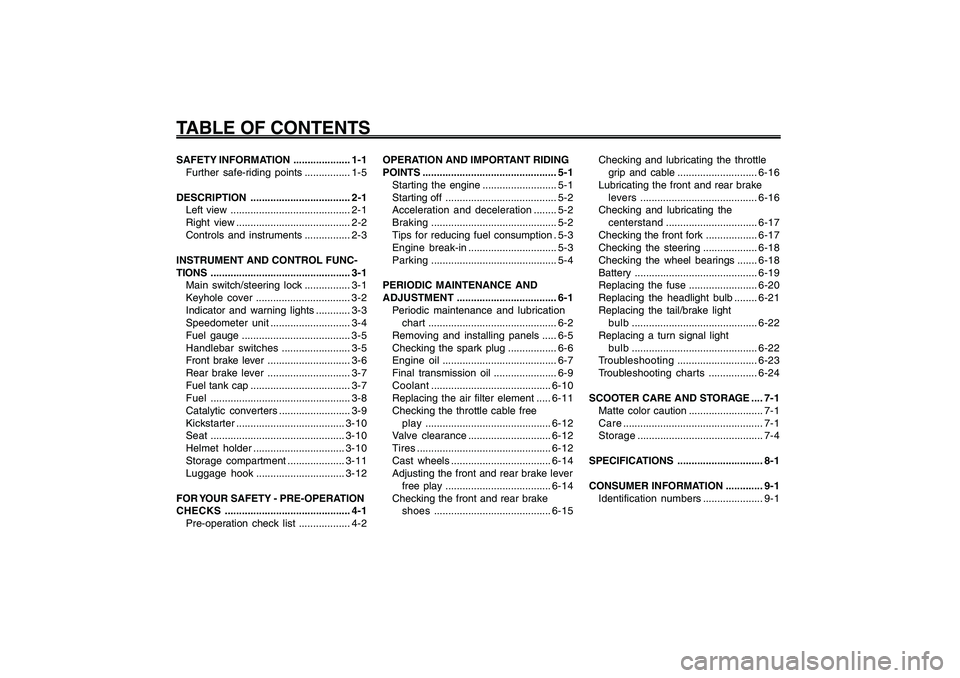
1
2
3
4
5
6
7
8
9
EAU10210
TABLE OF CONTENTSSAFETY INFORMATION .................... 1-1
Further safe-riding points ................ 1-5
DESCRIPTION ................................... 2-1
Left view .......................................... 2-1
Right view ........................................ 2-2
Controls and instruments ................ 2-3
INSTRUMENT AND CONTROL FUNC-
TIONS................................................. 3-1
Main switch/steering lock ................ 3-1
Keyhole cover ................................. 3-2
Indicator and warning lights ............ 3-3
Speedometer unit............................ 3-4
Fuel gauge ...................................... 3-5
Handlebar switches........................ 3-5
Front brake lever ............................. 3-6
Rear brake lever ............................. 3-7
Fuel tank cap ................................... 3-7
Fuel................................................. 3-8
Catalytic converters ......................... 3-9
Kickstarter......................................3-10
Seat...............................................3-10
Helmet holder................................3-10
Storage compartment ....................3-11
Luggage hook...............................3-12
FOR YOUR SAFETY - PRE-OPERATION
CHECKS............................................ 4-1
Pre-operation check list .................. 4-2OPERATION AND IMPORTANT RIDING
POINTS............................................... 5-1
Starting the engine .......................... 5-1
Starting off ....................................... 5-2
Acceleration and deceleration........ 5-2
Braking............................................ 5-2
Tips for reducing fuel consumption . 5-3
Engine break-in............................... 5-3
Parking............................................ 5-4
PERIODIC MAINTENANCE AND
ADJUSTMENT................................... 6-1
Periodic maintenance and lubrication
chart............................................. 6-2
Removing and installing panels ..... 6-5
Checking the spark plug ................. 6-6
Engine oil........................................ 6-7
Final transmission oil ...................... 6-9
Coolant..........................................6-10
Replacing the air filter element .....6-11
Checking the throttle cable free
play............................................6-12
Valve clearance.............................6-12
Tires...............................................6-12
Cast wheels ...................................6-14
Adjusting the front and rear brake lever
free play .....................................6-14
Checking the front and rear brake
shoes.........................................6-15Checking and lubricating the throttle
grip and cable ............................6-16
Lubricating the front and rear brake
levers.........................................6-16
Checking and lubricating the
centerstand................................6-17
Checking the front fork ..................6-17
Checking the steering ...................6-18
Checking the wheel bearings .......6-18
Battery ...........................................6-19
Replacing the fuse ........................6-20
Replacing the headlight bulb ........6-21
Replacing the tail/brake light
bulb............................................6-22
Replacing a turn signal light
bulb............................................6-22
Troubleshooting............................6-23
Troubleshooting charts.................6-24
SCOOTER CARE AND STORAGE .... 7-1
Matte color caution .......................... 7-1
Care................................................. 7-1
Storage............................................ 7-4
SPECIFICATIONS.............................. 8-1
CONSUMER INFORMATION ............. 9-1
Identification numbers..................... 9-1
Page 11 of 74

1-11
EAU10221
Q QQ Q
Q
SAFETY INFORMATION
1
2
3
4
5
6
7
8
9
1-4
able only from a Yamaha dealer, have
been designed, tested, and approved by
Yamaha for use on your vehicle.
Many companies with no connection to
Yamaha manufacture parts and acces-
sories or offer other modifications for
Yamaha vehicles. Yamaha is not in a
position to test the products that these
aftermarket companies produce. There-
fore, Yamaha can neither endorse nor
recommend the use of accessories not
sold by Yamaha or modifications not
specifically recommended by Yamaha,
even if sold and installed by a Yamaha
dealer.
Aftermarket Parts, Accessories, and
Modifications
While you may find aftermarket products
similar in design and quality to genuine
Yamaha accessories, recognize that
some aftermarket accessories or modi-
fications are not suitable because of
potential safety hazards to you or oth-
ers. Installing aftermarket products or
having other modifications performed toyour vehicle that change any of the
vehicle’s design or operation character-
istics can put you and others at greater
risk of serious injury or death. You are
responsible for injuries related to
changes in the vehicle.
Keep the following guidelines in mind,
as well as those provided under “Load-
ing” when mounting accessories.
●
Never install accessories or carry
cargo that would impair the perfor-
mance of your scooter. Carefully
inspect the accessory before us-
ing it to make sure that it does not
in any way reduce ground clear-
ance or cornering clearance, limit
suspension travel, steering travel
or control operation, or obscure
lights or reflectors.
Accessories fitted to the
handlebar or the front fork area
can create instability due to
improper weight distribution or
aerodynamic changes. If
accessories are added to the
handlebar or front fork area,they must be as lightweight as
possible and should be kept to
a minimum.
Bulky or large accessories may
seriously affect the stability of
the scooter due to aerodynamic
effects. Wind may attempt to
lift the scooter, or the scooter
may become unstable in cross
winds. These accessories may
also cause instability when
passing or being passed by
large vehicles.
Certain accessories can
displace the operator from his
or her normal riding position.
This improper position limits
the freedom of movement of
the operator and may limit
control ability, therefore, such
accessories are not recom-
mended.
●
Use caution when adding electrical
accessories. If electrical accesso-
ries exceed the capacity of the
scooter’s electrical system, an elec-
Page 12 of 74

1-12
EAU10221
Q QQ Q
Q
SAFETY INFORMATION
1
2
3
4
5
6
7
8
9
EAUT2030
Further safe-riding points●
Make sure to signal clearly when
making turns.
●
Braking can be extremely difficult
on a wet road. Avoid hard braking,
because the scooter could slide.
Apply the brakes slowly when stop-
ping on a wet surface.
●
Slow down as you approach a cor-
ner or turn. Once you have com-
pleted a turn, accelerate slowly.
●
Be careful when passing parked
cars. A driver might not see you and
open a door in your path.
●
Railroad crossings, streetcar rails,
iron plates on road construction
sites, and manhole covers become
extremely slippery when wet. Slow
down and cross them with caution.
Keep the scooter upright, otherwise
it could slide out from under you.
●
The brake lining could get wet when
you wash the scooter. After wash-
ing the scooter, check the brakes
before riding.
●
Always wear a helmet, gloves, trou-
sers (tapered around the cuff and
ankle so they do not flap), and a
bright colored jacket.
●
Do not carry too much luggage on
the scooter. An overloaded scooter
is unstable.
1-5
Safe-riding points
tric failure could result, which could
cause a dangerous loss of lights or
engine power.
Aftermarket Tires and Rims
The tires and rims that came with your
scooter were designed to match the
performance capabilities and to provide
the best combination of handling, brak-
ing, and comfort. Other tires, rims, sizes,
and combinations may not be appropri-
ate. Refer to page 6-12 for tire specifi-
cations and more information on replac-
ing your tires.
Page 19 of 74
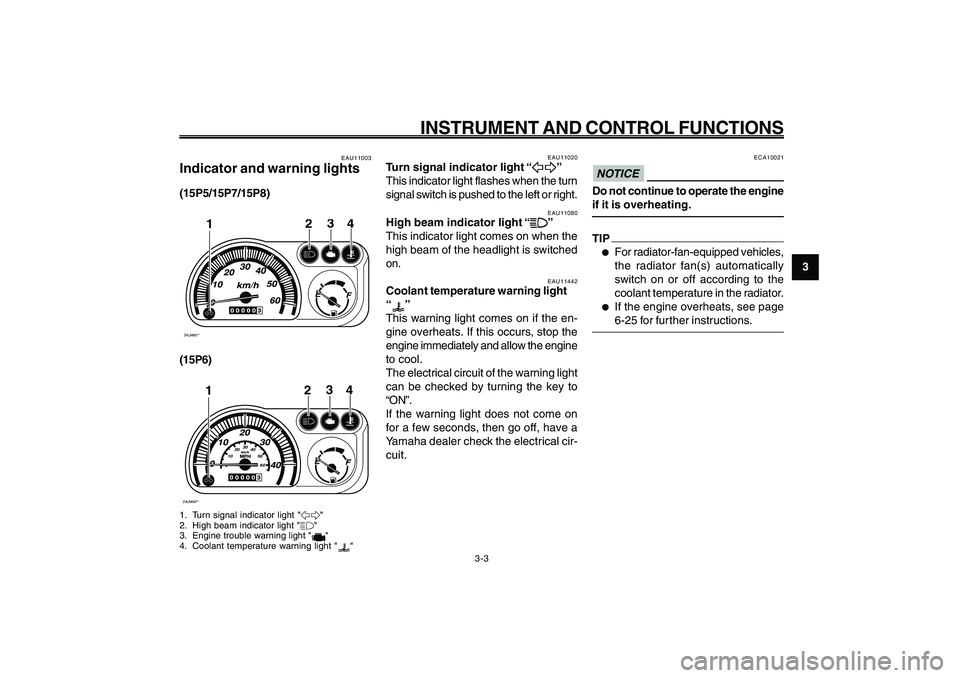
3-19
1
2
3
4
5
6
7
8
9
EAU1044E
INSTRUMENT AND CONTROL FUNCTIONS
EAU11020
Turn signal indicator light “
5 55 5
5”
This indicator light flashes when the turn
signal switch is pushed to the left or right.
EAU11080
High beam indicator light “
& && &
&”
This indicator light comes on when the
high beam of the headlight is switched
on. Indicator and warning lights
Turn signal indicator light
High beam indicator light
Coolant temperature warning light
EAU11442
Coolant temperature warning light
“
”
This warning light comes on if the en-
gine overheats. If this occurs, stop the
engine immediately and allow the engine
to cool.
The electrical circuit of the warning light
can be checked by turning the key to
“ON”.
If the warning light does not come on
for a few seconds, then go off, have a
Yamaha dealer check the electrical cir-
cuit.
3-3
EAU11003
Indicator and warning lights(15P5/15P7/15P8)ZAUM00**
3
24
1
(15P6)ZAUM00**
0102030
40
50
60
3
24
1
1. Turn signal indicator light "5"
2. High beam indicator light "&"
3. Engine trouble warning light "
"
4. Coolant temperature warning light "
"
ECA10021
NOTICEDo not continue to operate the engine
if it is overheating.TIP●
For radiator-fan-equipped vehicles,
the radiator fan(s) automatically
switch on or off according to the
coolant temperature in the radiator.
●
If the engine overheats, see page
6-25 for further instructions.
Page 22 of 74
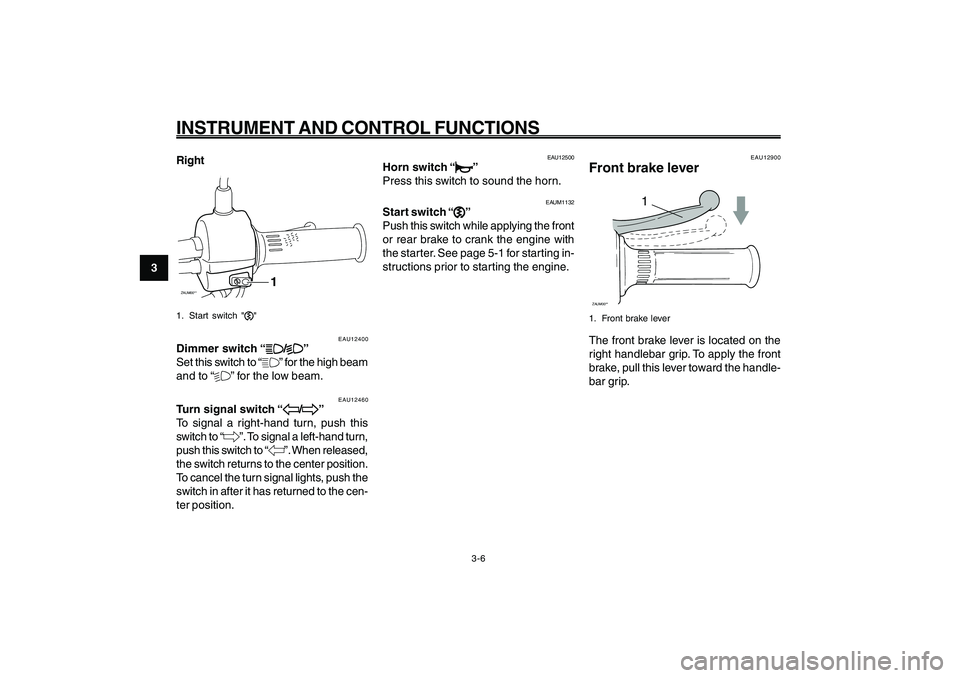
3-22
1
2
3
4
5
6
7
8
9
EAU1044E
INSTRUMENT AND CONTROL FUNCTIONSDimmer switch
Turn signal switch
Horn switch
Start switch
Brake lever, front
EAU12460
Turn signal switch “
4 44 4
4/
6 66 6
6”
To signal a right-hand turn, push this
switch to “6”. To signal a left-hand turn,
push this switch to “4”. When released,
the switch returns to the center position.
To cancel the turn signal lights, push the
switch in after it has returned to the cen-
ter position.
EAU12500
Horn switch “
* ** *
*”
Press this switch to sound the horn.
EAU12400
Dimmer switch “
& && &
&/
% %% %
%”
Set this switch to “&” for the high beam
and to “%” for the low beam.
EAUM1132
Start switch “
, ,, ,
,”
Push this switch while applying the front
or rear brake to crank the engine with
the starter. See page 5-1 for starting in-
structions prior to starting the engine.
3-6
EAU12900
Front brake lever
1
ZAUM00**1. Front brake leverThe front brake lever is located on the
right handlebar grip. To apply the front
brake, pull this lever toward the handle-
bar grip. Right
ZAUM00**
1
1. Start switch ","
Page 24 of 74
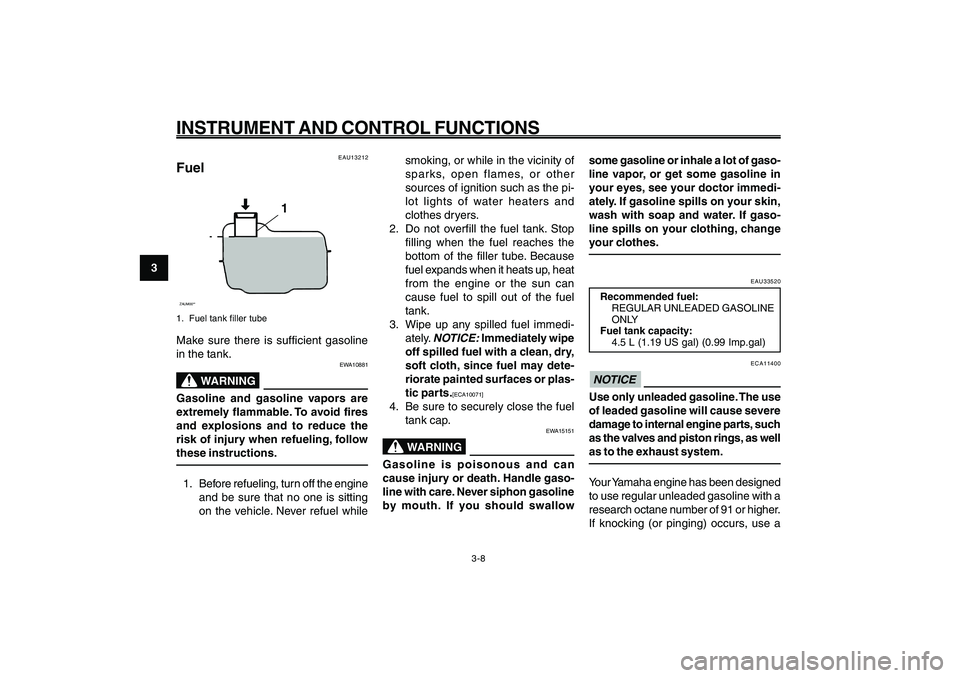
3-24
1
2
3
4
5
6
7
8
9
EAU1044E
INSTRUMENT AND CONTROL FUNCTIONS
3-8
smoking, or while in the vicinity of
sparks, open flames, or other
sources of ignition such as the pi-
lot lights of water heaters and
clothes dryers.
2. Do not overfill the fuel tank. Stop
filling when the fuel reaches the
bottom of the filler tube. Because
fuel expands when it heats up, heat
from the engine or the sun can
cause fuel to spill out of the fuel
tank.
3. Wipe up any spilled fuel immedi-
ately.
NOTICE:
Immediately wipe
off spilled fuel with a clean, dry,
soft cloth, since fuel may dete-
riorate painted surfaces or plas-
tic parts.
[ECA10071]
4. Be sure to securely close the fuel
tank cap.
EWA15151
WARNING
Gasoline is poisonous and can
cause injury or death. Handle gaso-
line with care. Never siphon gasoline
by mouth. If you should swallowsome gasoline or inhale a lot of gaso-
line vapor, or get some gasoline in
your eyes, see your doctor immedi-
ately. If gasoline spills on your skin,
wash with soap and water. If gaso-
line spills on your clothing, change
your clothes.
EAU33520
Recommended fuel:
REGULAR UNLEADED GASOLINE
ONLY
Fuel tank capacity:
4.5 L (1.19 US gal) (0.99 Imp.gal)
ECA11400
NOTICEUse only unleaded gasoline. The use
of leaded gasoline will cause severe
damage to internal engine parts, such
as the valves and piston rings, as well
as to the exhaust system.Your Yamaha engine has been designed
to use regular unleaded gasoline with a
research octane number of 91 or higher.
If knocking (or pinging) occurs, use a
EAU13212
FuelZAUM00**
1
1. Fuel tank filler tubeMake sure there is sufficient gasoline
in the tank.
EWA10881
WARNING
Gasoline and gasoline vapors are
extremely flammable. To avoid fires
and explosions and to reduce the
risk of injury when refueling, follow
these instructions.1. Before refueling, turn off the engine
and be sure that no one is sitting
on the vehicle. Never refuel while Fuel
Page 31 of 74

4-31
1
2
3
4
5
6
7
8
9
EAU15582
FOR YOUR SAFETY - PRE-OPERATION CHECKS
4-3
Centerstand• Make sure that operation is smooth.
• Lubricate pivots if necessary.6-17
Chassis fasteners• Make sure that all nuts, bolts and screws are properly tightened.
• Tighten if necessary.-
Instruments, lights, signals
and switches• Check operation.
• Correct if necessary.3-3, 3-5 ITEM CHECKS PAGE
Page 32 of 74
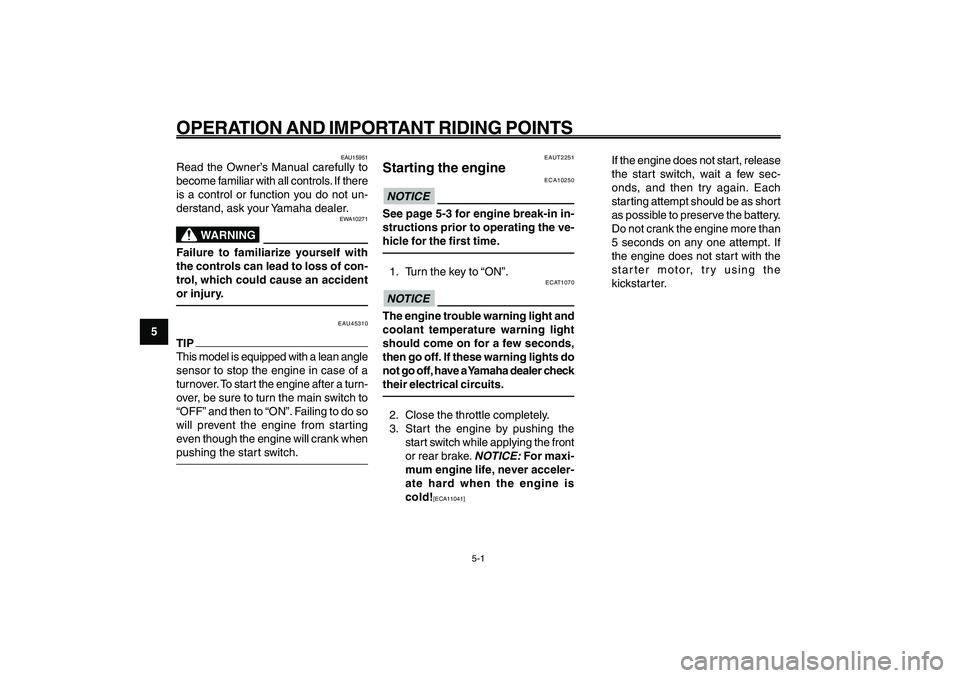
5-32
1
2
3
4
5
6
7
8
9
EAU15943
OPERATION AND IMPORTANT RIDING POINTS
EAU15943
OPERATION AND IMPORTANT RIDING POINTS
5-1
Starting the engine
EAU15951
Read the Owner’s Manual carefully to
become familiar with all controls. If there
is a control or function you do not un-
derstand, ask your Yamaha dealer.
EWA10271
WARNING
Failure to familiarize yourself with
the controls can lead to loss of con-
trol, which could cause an accident
or injury.
EAU45310
TIP
This model is equipped with a lean angle
sensor to stop the engine in case of a
turnover. To start the engine after a turn-
over, be sure to turn the main switch to
“OFF” and then to “ON”. Failing to do so
will prevent the engine from starting
even though the engine will crank when
pushing the start switch.
EAUT2251
Starting the engine
ECA10250
NOTICESee page 5-3 for engine break-in in-
structions prior to operating the ve-
hicle for the first time.1. Turn the key to “ON”.
ECAT1070
NOTICEThe engine trouble warning light and
coolant temperature warning light
should come on for a few seconds,
then go off. If these warning lights do
not go off, have a Yamaha dealer check
their electrical circuits.2. Close the throttle completely.
3. Start the engine by pushing the
start switch while applying the front
or rear brake.
NOTICE:
For maxi-
mum engine life, never acceler-
ate hard when the engine is
cold!
[ECA11041]
If the engine does not start, release
the start switch, wait a few sec-
onds, and then try again. Each
starting attempt should be as short
as possible to preserve the battery.
Do not crank the engine more than
5 seconds on any one attempt. If
the engine does not start with the
starter motor, try using the
kickstar ter.
Page 34 of 74
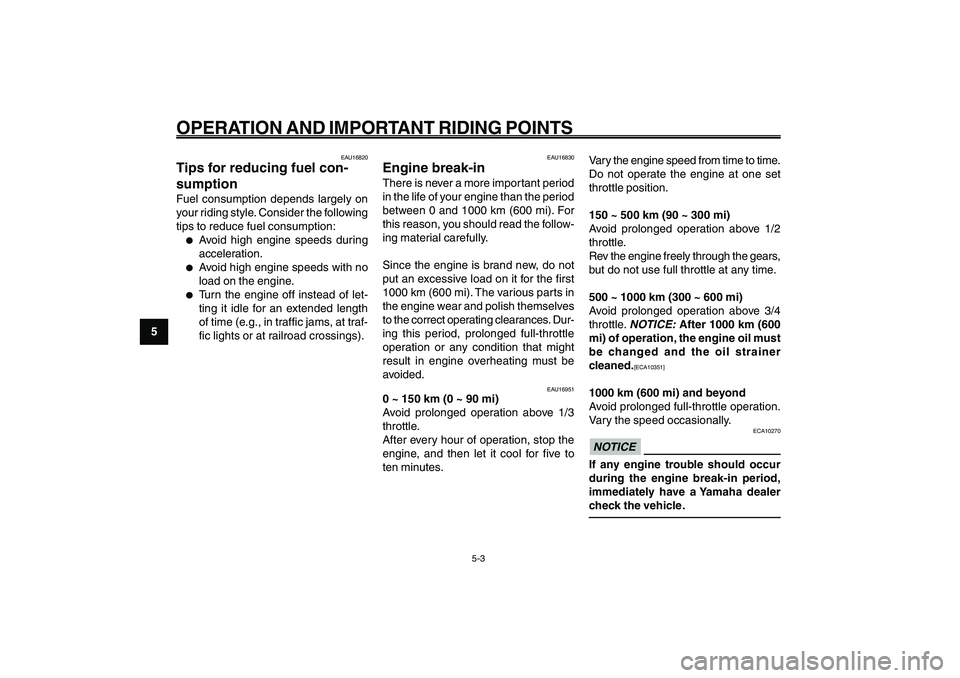
5-34
1
2
3
4
5
6
7
8
9
EAU15943
OPERATION AND IMPORTANT RIDING POINTS
5-3
EAU16830
Engine break-inThere is never a more important period
in the life of your engine than the period
between 0 and 1000 km (600 mi). For
this reason, you should read the follow-
ing material carefully.
Since the engine is brand new, do not
put an excessive load on it for the first
1000 km (600 mi). The various parts in
the engine wear and polish themselves
to the correct operating clearances. Dur-
ing this period, prolonged full-throttle
operation or any condition that might
result in engine overheating must be
avoided. Fuel consumption, tips for reducing
Engine break-in
EAU16820
Tips for reducing fuel con-
sumptionFuel consumption depends largely on
your riding style. Consider the following
tips to reduce fuel consumption:●
Avoid high engine speeds during
acceleration.
●
Avoid high engine speeds with no
load on the engine.
●
Turn the engine off instead of let-
ting it idle for an extended length
of time (e.g., in traffic jams, at traf-
fic lights or at railroad crossings).
EAU16951
0 ~ 150 km (0 ~ 90 mi)
Avoid prolonged operation above 1/3
throttle.
After every hour of operation, stop the
engine, and then let it cool for five to
ten minutes.Vary the engine speed from time to time.
Do not operate the engine at one set
throttle position.
150 ~ 500 km (90 ~ 300 mi)
Avoid prolonged operation above 1/2
throttle.
Rev the engine freely through the gears,
but do not use full throttle at any time.
500 ~ 1000 km (300 ~ 600 mi)
Avoid prolonged operation above 3/4
throttle.
NOTICE:
After 1000 km (600
mi) of operation, the engine oil must
be changed and the oil strainer
cleaned.
[ECA10351]
1000 km (600 mi) and beyond
Avoid prolonged full-throttle operation.
Vary the speed occasionally.
ECA10270
NOTICEIf any engine trouble should occur
during the engine break-in period,
immediately have a Yamaha dealer
check the vehicle.
Page 39 of 74
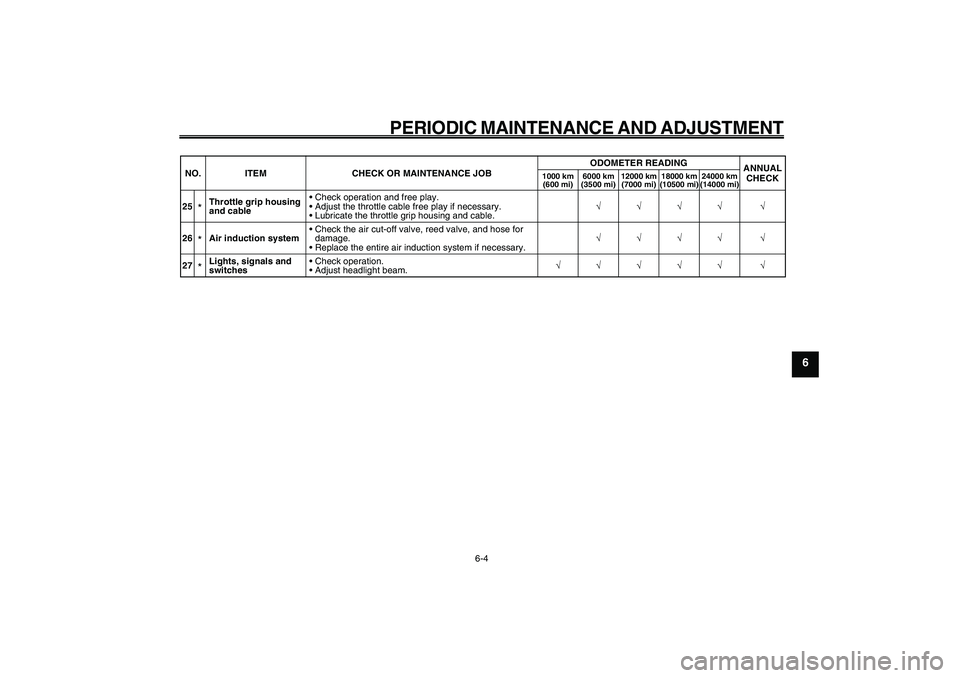
6-39
1
2
3
4
5
6
7
8
9
EAU1722A
PERIODIC MAINTENANCE AND ADJUSTMENT
6-4
25
*Throttle grip housing
and cable• Check operation and free play.
• Adjust the throttle cable free play if necessary.
• Lubricate the throttle grip housing and cable.�—�—�—�— �—
26*Air induction system• Check the air cut-off valve, reed valve, and hose for
damage.
• Replace the entire air induction system if necessary.�—�—�—�— �—
27*Lights, signals and
switches• Check operation.
• Adjust headlight beam.�—�—�—�—�— �— NO. ITEM CHECK OR MAINTENANCE JOBODOMETER READING
ANNUAL
CHECK
1000 km
(600 mi)6000 km
(3500 mi)12000 km
(7000 mi)18000 km
(10500 mi)24000 km
(14000 mi)